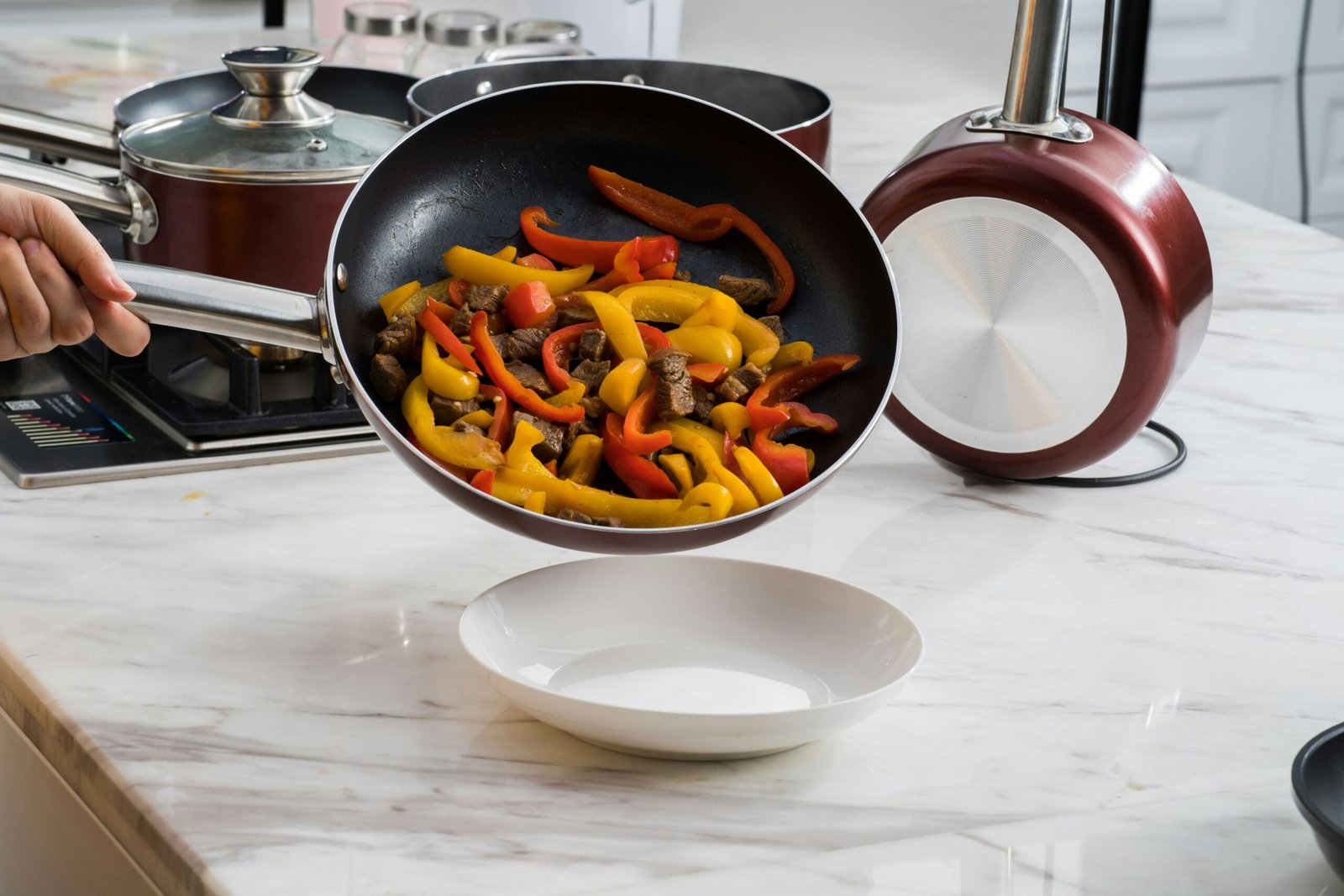The non-stick debate isn’t going away anytime soon. Ceramic or Teflon? Both make cooking and cleanup easier, but they’re not created equal. One’s the clean, toxin-free minimalist. The other’s the long-haul performer. If you’ve ever stood in the cookware aisle wondering which one’s worth your money, this breakdown will save you a few headaches (and maybe a few burnt eggs).
How They Handle Heat: Ceramic Cookware vs Teflon Non-Stick
Ceramic Cookware
Ceramic pans heat up fast. The mineral coating grabs heat quickly and spreads it evenly, which means you don’t need to crank up the stove. That’s great for delicate foods like fish or scrambled eggs that burn easily. You’ll find you can cook the same omelet on medium heat instead of high, and it still comes out golden.
If you want a reliable ceramic set, GreenPan Valencia Pro is a fantastic choice. It’s PFAS-free, heats evenly, and gets rave reviews from home chefs who care about safety and performance. If you want something more stylish for your kitchen, the Caraway 10-Piece Ceramic Cookware Set is another favorite. It’s toxin-free, Instagram-worthy, and great for everyday meals.
Why people love ceramic:
- Quick, even heating
- Lower temperatures save energy
- Eco-friendly, chemical-free coating
- Great for everyday cooking
The only downside? Ceramic reacts fast. Walk away for a minute and your stir-fry might go from perfect to crispy in seconds. Keep an eye on it.
Teflon Non-Stick
Teflon’s been around forever, and honestly, it’s earned that reputation. Its PTFE coating gives it that smooth, slippery surface where eggs practically levitate off the pan. In one popular “50-egg test,” Teflon held its non-stick quality even after dozens of rounds without sticking once. That’s serious endurance.
If you’re looking for dependable non-stick cookware, you can’t go wrong with T-fal Ultimate Hard Anodized Nonstick. It’s a workhorse for everyday cooking and perfect for family meals. If you prefer something sleeker and higher-end, All-Clad HA1 Nonstick gives you pro-level heat distribution and long-term durability.
Why people still swear by Teflon:
- Super slick and easy to clean
- Works well under steady, moderate heat
- Requires little to no oil
- Ideal for pancakes, stir-fries, and fast meals
Bottom line:
Ceramic reacts fast and gives you control. Teflon is the steady, forgiving partner when you just want to get dinner done without drama.
Health and Safety: What’s Really in Your Pan
The Teflon Talk
Here’s the truth. Teflon works beautifully, but it has limits. Push it past 500°F and it can start breaking down, releasing fumes tied to PFAS compounds—chemicals you don’t want near your food. So if you’re someone who loves high-heat searing, stick to medium and don’t preheat your pan empty.
Teflon safety tips:
- Keep heat below 500°F
- Avoid cheap non-stick sprays
- Never use metal utensils
- Stick with trusted brands like Calphalon Contemporary Nonstick or Anolon Advanced Nonstick, which use stronger, more stable coatings
Why Ceramic Feels Safer
Ceramic cookware is made from natural minerals and baked into a glass-like finish. No PFAS. No PTFE. No harmful fumes. It’s the healthier, eco-conscious choice, and it looks great, too. Plus, high-quality options like GreenPan and Caraway are proving you don’t have to trade style for performance.
Why it’s the cleaner choice:
- Chemical-free and non-toxic
- Safe at high temperatures
- Eco-friendly production process
If you’re someone who values cleaner living and safer cooking, ceramic wins this round easily.
How to Keep Your Pans in Great Shape
Cookware’s like skincare—it lasts longer when you treat it right. Follow these quick habits and you’ll get years of use from your pans.
For Ceramic:
- Use medium or low heat
- Stick to wooden or silicone utensils
- Don’t cool it too fast with cold water
- Hand wash gently and dry completely
For Teflon:
- Never use metal utensils
- Skip the aerosol sprays—they ruin the surface
- Keep it under 500°F
- Stack with soft cloths or paper towels in between
If you want your pans to stay slick, brush on a little oil before cooking. It protects the coating and boosts performance.
Which One’s Worth Your Money?
It depends on your priorities. Teflon lasts longer if you treat it gently. It’s low-maintenance and consistent—perfect for busy cooks who want results without overthinking it. Ceramic, on the other hand, gives you peace of mind. It’s safer, cleaner, and ideal for those who care about health and sustainability.
If you’re shopping:
- For durability: T-fal Ultimate Hard Anodized Nonstick or All-Clad HA1 Nonstick
- For toxin-free style: Caraway 10-Piece Ceramic Cookware or GreenPan Valencia Pro
- For a classic affordable pick: Cuisinart Chef’s Classic Nonstick—a great starter set that performs above its price
Final Thoughts
Both deserve a spot in your kitchen for different reasons. Ceramic brings clean, health-forward energy—safe, fast, and modern. Teflon brings reliability—long-lasting and easy to love.
If you cook intuitively and care about safety, go ceramic. If you want a dependable everyday workhorse, go Teflon. Either way, treat your pans with care and they’ll return the favor for years to come.
FAQ
What makes ceramic different from Teflon?
Ceramic uses a mineral-based coating made from sand, while Teflon relies on a PTFE polymer. Ceramic heats faster and doesn’t need as much heat to cook well.
Which is safer for high-heat cooking?
Ceramic. It stays stable and doesn’t release fumes, even when cooking hot. Teflon must be kept below 500°F.
Which lasts longer?
Teflon usually does, as long as you handle it gently. Ceramic can wear faster but stays toxin-free.
How should I care for them?
Hand wash both. Use non-metal utensils. Go easy on heat with ceramic and never overheat Teflon.
Which is more eco-friendly?
Ceramic. It’s made from natural minerals and doesn’t contain PFAS or synthetic chemicals, making it the greener choice.






